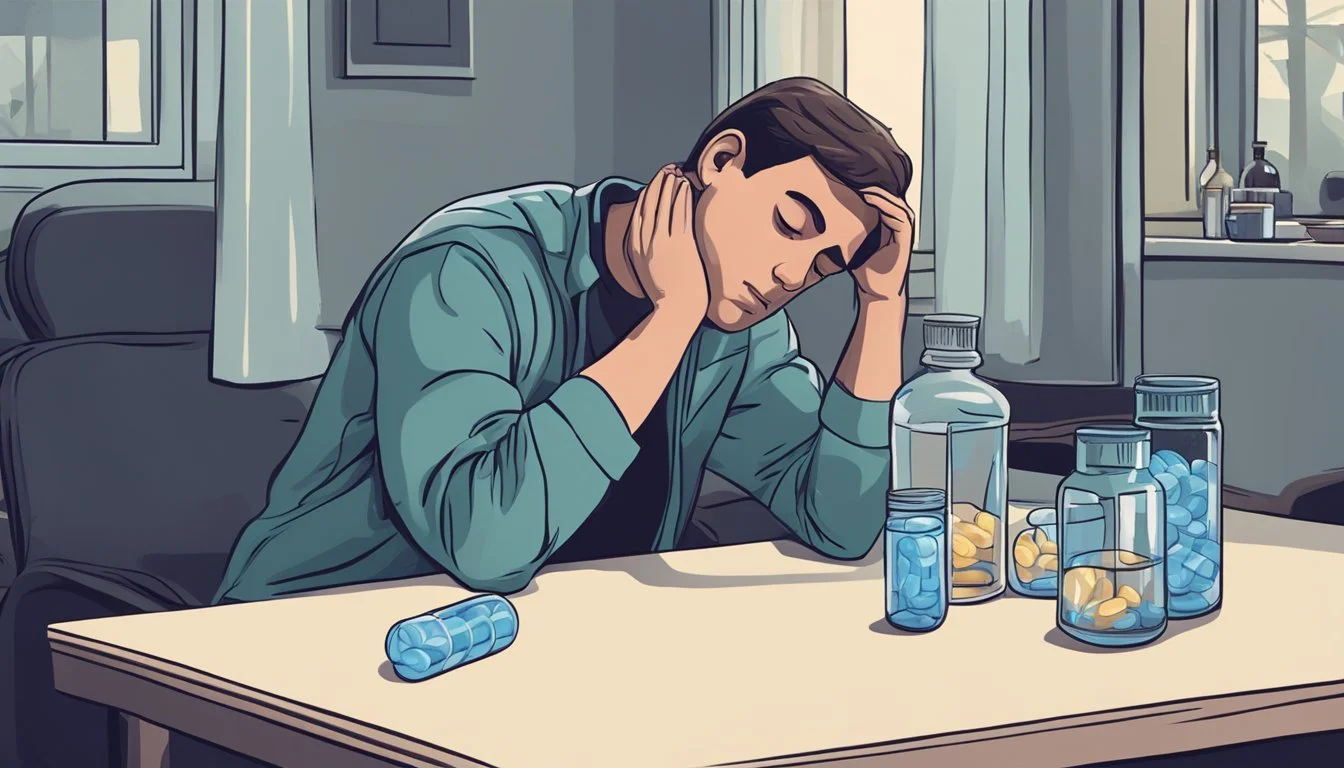Understanding the Role of Benzodiazepines in Treating Panic Attacks
Benzodiazepines, commonly known as "benzos," are a class of medications frequently prescribed for the treatment of panic attacks and anxiety disorders. These drugs work by enhancing the effects of GABA, a neurotransmitter that helps calm brain activity. For individuals experiencing panic attacks, benzodiazepines can provide rapid relief from symptoms such as heart palpitations, sweating, trembling, and feelings of impending doom.
While benzodiazepines can be effective in managing acute panic attacks, they are generally not recommended as a first-line treatment for panic disorder. Selective serotonin reuptake inhibitors (SSRIs) and cognitive-behavioral therapy are typically preferred long-term strategies. Benzodiazepines may be used in combination with these treatments during the initial phases to provide immediate symptom relief.
It's important to note that benzodiazepines carry risks of dependence and withdrawal, especially with prolonged use. Their use should be carefully monitored by healthcare professionals. Common benzodiazepines prescribed for panic attacks include alprazolam (Xanax) and clonazepam (Klonopin). These medications can be valuable tools in managing panic attacks when used appropriately under medical supervision.
Understanding Panic Attacks and Panic Disorder
Panic attacks and panic disorder are characterized by intense episodes of fear and anxiety. These conditions can significantly impact a person's daily life and well-being.
Definition and Symptoms of Panic Attacks
Panic attacks are sudden surges of overwhelming fear that come without warning. Physical symptoms include rapid heartbeat, sweating, trembling, and shortness of breath. Some people experience chest pain, nausea, or a feeling of detachment from reality.
Panic attacks typically peak within minutes. Many individuals report a fear of losing control or dying during an attack. While extremely distressing, panic attacks are not physically dangerous.
Anatomy of Panic Disorder
Panic disorder develops when a person experiences recurrent, unexpected panic attacks. These individuals often live in fear of having another attack. This constant worry can lead to significant changes in behavior, such as avoiding places where attacks have occurred.
To be diagnosed with panic disorder, a person must have frequent panic attacks that are not tied to a specific situation. The condition often co-occurs with other anxiety disorders or depression.
The Role of Fear and Anxiety in Panic
Fear and anxiety are central to panic attacks and panic disorder. During an attack, the body's fight-or-flight response activates, even without a real threat present. This leads to the physical symptoms associated with panic.
Anxiety about future attacks can create a cycle of fear. People may become hypersensitive to bodily sensations, interpreting normal changes as signs of an impending attack. This heightened awareness can actually trigger panic attacks.
Learning to manage fear and anxiety is key to treating panic disorder. Cognitive-behavioral therapy helps individuals identify and challenge anxious thoughts, breaking the cycle of panic.
The Science of Benzodiazepines
Benzodiazepines work by enhancing the effects of a key neurotransmitter in the brain to produce calming effects. Their mechanism of action involves complex interactions at specific receptor sites.
How Benzodiazepines Affect the Brain
Benzodiazepines bind to specific sites on GABA-A receptors in the brain. This binding enhances the effects of GABA, the main inhibitory neurotransmitter in the central nervous system.
The enhanced GABA activity leads to decreased nerve cell excitability. This results in the sedative, anxiolytic, and muscle relaxant effects of benzodiazepines.
Different benzodiazepines have varying affinities for GABA receptor subtypes. This accounts for their different potencies and duration of action.
Benzodiazepines also affect other neurotransmitter systems indirectly. They can modulate serotonin, norepinephrine, and dopamine activity.
GABA Neurotransmitter and Anxiety Relief
GABA is the primary inhibitory neurotransmitter in the brain. It reduces neuronal excitability throughout the nervous system.
Low GABA levels are associated with anxiety, restlessness, and insomnia. Benzodiazepines amplify GABA's natural calming effect.
This enhanced GABA signaling decreases the firing rate of neurons. It inhibits the release of other neurotransmitters like norepinephrine and serotonin.
The result is a reduction in anxiety, muscle tension, and autonomic arousal. Patients often report feeling more relaxed and less worried.
Regular benzodiazepine use can lead to tolerance. The brain adapts to the increased GABA activity over time.
Common Benzodiazepines for Panic Attacks
Several benzodiazepines are frequently prescribed for managing panic attacks. These medications work by enhancing the effects of GABA, a neurotransmitter that reduces brain activity and promotes calmness.
Alprazolam and Its Use in Treatment
Alprazolam, known by the brand name Xanax, is a fast-acting benzodiazepine commonly used for panic disorder. It typically takes effect within 1-2 hours and lasts for 4-6 hours. Dosages range from 0.25mg to 4mg daily, divided into multiple doses.
Alprazolam is particularly effective for acute panic attacks due to its rapid onset. However, it carries a higher risk of dependence compared to other benzodiazepines.
Side effects may include drowsiness, dizziness, and coordination problems. Patients are advised against driving or operating machinery until they know how the medication affects them.
Clonazepam: Dosage and Effects
Clonazepam, sold under the brand name Klonopin, is a longer-acting benzodiazepine used for panic disorder. It has a slower onset but longer duration of action, typically lasting 8-12 hours.
The usual starting dose is 0.25mg twice daily, which can be increased gradually to 1-2mg per day. Clonazepam's extended effects make it suitable for preventing panic attacks rather than treating acute episodes.
Common side effects include sleepiness, dizziness, and impaired concentration. Some patients report improved sleep quality while taking clonazepam.
Diazepam and Lorazepam Applications
Diazepam (Valium) and lorazepam (Ativan) are also prescribed for panic attacks, though less frequently than alprazolam or clonazepam.
Diazepam has a long half-life, providing extended anxiety relief. It's often used at doses of 2-10mg daily. Lorazepam acts more quickly and is shorter-lasting, typically prescribed at 0.5-2mg doses taken 2-3 times daily.
Both medications can effectively reduce panic symptoms. Diazepam may be preferred for patients with concurrent muscle tension, while lorazepam's shorter duration can be beneficial for those prone to daytime drowsiness.
Side effects for both include sedation and potential cognitive impairment. As with all benzodiazepines, these medications carry risks of dependence and withdrawal symptoms if stopped abruptly.
Comparing Benzodiazepines with Other Treatments
Benzodiazepines are not the only option for treating panic disorder. Other effective treatments include antidepressants and various forms of psychotherapy.
Selective Serotonin Reuptake Inhibitors (SSRIs)
SSRIs are often considered the first-line treatment for panic disorder. These medications work by increasing serotonin levels in the brain, which can help regulate mood and reduce anxiety.
SSRIs typically have fewer side effects than benzodiazepines and are not habit-forming. They may take several weeks to reach full effectiveness, unlike the rapid action of benzodiazepines.
Common SSRIs prescribed for panic disorder include:
Fluoxetine
Paroxetine
Sertraline
Escitalopram
While SSRIs can be effective, some patients may experience initial increased anxiety or sexual side effects.
The Role of Therapy in Managing Panic Disorders
Psychotherapy, particularly cognitive behavioral therapy (CBT), plays a crucial role in treating panic disorders. CBT helps patients identify and change thought patterns that contribute to panic attacks.
Key components of CBT for panic disorder include:
Exposure therapy
Relaxation techniques
Cognitive restructuring
Studies have shown that CBT can be as effective as medication for many patients with panic disorder. It provides long-term benefits and equips individuals with coping strategies to manage future panic symptoms.
Combining therapy with medication often yields the best results for severe cases of panic disorder.
Potential Side Effects and Risks of Benzodiazepines
Benzodiazepines can cause various adverse effects and carry significant risks, particularly with long-term use. These medications may lead to physical dependence, withdrawal symptoms, and cognitive impairment.
Understanding the Risk of Dependency and Withdrawal
Benzodiazepines can cause physical dependence, even when taken as prescribed. Tolerance develops quickly, often leading to increased dosage. Withdrawal symptoms may occur when stopping or reducing use, including:
Anxiety and panic attacks
Insomnia
Tremors
Nausea and vomiting
Sweating
Muscle pain and stiffness
Withdrawal can be severe and potentially life-threatening. It may last weeks or months. Tapering off benzodiazepines under medical supervision is crucial to minimize risks.
Psychological dependence is also common. Users may feel unable to cope without the medication, leading to prolonged use and difficulty discontinuing.
Recognizing Signs of Overdose and Adverse Effects
Common side effects of benzodiazepines include:
Drowsiness and sedation
Dizziness
Confusion
Memory problems
Impaired coordination
More serious adverse effects can occur, especially with higher doses or when combined with other substances:
Respiratory depression
Severe confusion and disorientation
Loss of consciousness
Paradoxical reactions (increased anxiety or agitation)
Signs of overdose include:
Extreme drowsiness
Slurred speech
Lack of coordination
Slow or shallow breathing
Coma
Immediate medical attention is necessary if overdose is suspected. Long-term use may lead to cognitive decline and increased risk of falls, particularly in older adults.
Strategies for Managing Withdrawal Symptoms
Discontinuing benzodiazepine use requires careful planning and support. Proper tapering and alternative treatments can help minimize withdrawal symptoms and maintain anxiety control.
Tapering off Benzodiazepines Safely
Gradual dose reduction is essential for safe benzodiazepine discontinuation. A typical taper involves decreasing the dose by 5-10% every 1-2 weeks. This slow approach helps minimize withdrawal symptoms and allows the body to adjust.
Some doctors use a substitution method, switching to a longer-acting benzodiazepine before tapering. This can provide more stable blood levels and easier dosing.
Patients should work closely with their healthcare provider to create a personalized tapering plan. Factors like duration of use, dosage, and individual health considerations affect the ideal tapering schedule.
Withdrawal symptoms may still occur during tapering. Common issues include rebound anxiety, insomnia, and irritability. Doctors may prescribe temporary supportive medications to manage these symptoms.
Alternative Treatments for Anxiety and Panic Disorders
As benzodiazepine use is reduced, alternative treatments become crucial for managing anxiety and panic symptoms. Cognitive-behavioral therapy (CBT) is highly effective for anxiety disorders. It helps patients identify and change thought patterns that contribute to anxiety.
Selective serotonin reuptake inhibitors (SSRIs) are often prescribed as a long-term medication option. These antidepressants can effectively reduce anxiety with fewer risks than benzodiazepines.
Mindfulness and relaxation techniques provide valuable coping tools. Regular practice of deep breathing, progressive muscle relaxation, and meditation can help manage anxiety symptoms.
Exercise has proven benefits for mental health. Regular physical activity can reduce anxiety and improve mood. Even short daily walks can make a difference.
Considering Long-Term Effects and Research
Long-term benzodiazepine use for panic attacks requires careful evaluation of potential benefits and risks. Research has examined impacts on mental health, cognition, and daily functioning.
Studies on Long-Term Use of Benzodiazepines
Large-scale meta-analyses have shown benzodiazepines effectively reduce anxiety symptoms compared to placebo for conditions like generalized anxiety disorder and panic disorder. The risk of dependence appears lower than previously thought.
A systematic review found benzodiazepine monotherapy produced significant improvements on anxiety rating scales versus placebo. However, most clinical trials only assess short-term use.
Long-term effectiveness and safety remain less clear. Some studies indicate tolerance may develop over time, potentially reducing benefits. Cognitive effects like memory impairment are a concern, especially in older adults.
Exploring the Impact on Social Functioning and Mental Health
Research on social and mental health impacts of extended benzodiazepine use shows mixed results. Some patients report improved daily functioning and quality of life with ongoing treatment.
Others experience challenges like emotional blunting or difficulties with work and relationships. Proper dosing and periodic reassessment are crucial.
Studies examining links to dementia risk have been inconclusive. More research is needed on long-term cognitive effects.
Misuse and addiction remain important considerations, though rates appear lower than once believed. Careful patient selection and monitoring can help minimize risks.



